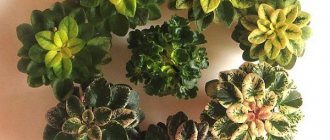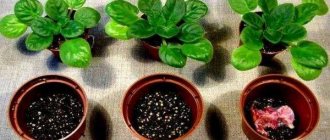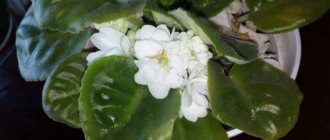For wick irrigation use a mixture of peat and perlite in equal parts without adding other ingredients.
Watering and fertilizing
The watering regime is very important, and you need to remember that water ingress:
- May leave burns on leaves;
And at the point of growth cause rotting.
Three methods of watering are used , on which the frequency of fertilizing depends:
- In a tray - the pots stand on a tray or trays 1-1.5 cm deep, and water is poured there, after watering the remainder is drained. The concentration of fertilizers for such irrigation should be half the recommended one. Watering frequency is on average once a week, and fertilizing every other watering;
- Under the leaves - water is poured through the soil, avoiding contact with the leaves. The frequency of watering and fertilizing conditions are the same as in the previous method;
- Wick – a wick is placed in a pot, removed through the drainage holes and lowered into a container of water. Fertilizers are constantly added to the water in quantities that are 7-8 times less than recommended.
Transplantation, pruning, rejuvenation
Young plants are regularly replanted , as they grow, usually they are simply transferred to a larger pot. Adult Saintpaulias are usually replanted once a year, with a complete replacement of the soil.
Saintpaulias need to be replanted once a year.
When replanting mature flowers, they are usually pruned and rejuvenated . First of all, remove the old ones:
- Leaves;
- Peduncles;
- And roots.
Leaves and peduncles are trimmed as needed, regardless of transplantation. If the rosette has aged or the stem has become very long, it is cut off by removing the lower part . If roots remain on the rosette, it is simply replanted, and if pruning occurs high, then the top is first rooted.
What the violet and marble rose love
Prairie gentian is finicky and prefers different temperatures at different times of the year. In summer - the temperature should not exceed 25 ᵒС and should not be lower than 20 ᵒС. In autumn and winter – not lower than 12 ᵒС and not higher than 15 ᵒС.
Eustoma loves light, so you need to try to ensure that the flower that is at home receives a sufficient amount of it. But the main thing is not to overdo it, otherwise it will burn.
The plant has a sensitive root system. Therefore, you need to be very careful about the content of salts, acids and alkalis in the soil. For indoor plants, you can use soil that is easy to find in the store.
Land is selected with the required amount:
- Minerals;
- Microelements;
- Peat;
- Sand.
A prerequisite must be that the pot is roomy and spacious in width and there are large holes at the bottom. When caring for Lisianthus, you need to ensure that they are pruned correctly to form a crown and additional cuttings. Eustoma loves a lot of water, so it has to be watered often. Unlike other plants, it should be watered already when the top of the post becomes dry. For watering, you need to use water that has had time to settle, because the plant is susceptible to various impurities. The flower requires care, so after watering, the water is poured out of the pan so that the roots do not rot. Be sure to ensure that moisture does not get on the leaves, this can develop fungal diseases on them. To prevent the flower from getting sick, leave the leaves dry.
During growth and flowering, especially in the spring and summer, the Mountain Rose needs to be fed. It is better to take fertilizers that contain potassium and phosphorus. These are the components she needs most. The violet got its name from its clear marbled pattern. They look like large beautiful semi-double and double flowers. These flowers are similar to a rose with a pale pink color. Equal amounts of red and white.
Features of flowering, growth and reproduction
Marble rose grows quite quickly:
- From baby to adult it takes about 10-12 months;
- And the first flowering occurs even earlier.
This variety blooms very profusely, but it is very difficult to achieve bouquet or cap flowering from it . This is due to the gradual blooming of flowers. Peduncles:
- Powerful;
- Medium height;
- Each one contains many buds.
But while the next one blooms, the previous one fades. Each flower lasts about a week, sometimes longer.
Depending on the lighting, the color of the flowers may vary slightly:
- The warmer and more light, the darker the flowers become and the less noticeable the pattern;
- And when the temperature drops and the lighting dims, the pattern is clearer and the light parts are larger.
Important! In hot weather there may be a decrease in flower size, but this can also happen if there are a large number of buds.
Many gardeners propagate Saintpaulias by leaf.
Varietal characteristics are transmitted by all methods of reproduction :
- Leaves - healthy leaf cuttings, cut in 3-4 rows, are rooted in a convenient way. Each cutting can produce 1-3 babies, which are planted and further grown;
- Peduncles - live, not withered peduncles, cut to a size of 1.5 cm below the receptacle node and 0.5 cm above, planted in the ground under the greenhouse. After rooting and formation of the children, they are seated and then cared for like other Saintpaulias;
- Seeds - they are sown in a greenhouse, and after germination they are further grown in such conditions. Next, the children are seated in separate pots and cared for like adult violets;
- Stepchildren - stepsons are formed in the leaf axils; after 4-6 leaves appear, they are cut off and rooted. Some gardeners deepen the mother plant until the stepson touches the ground and wait for the roots to appear on the latter.
Description of the violet variety and photo
The Le Rosemary variety differs from other Saintpaulia varieties by its lush flowering; one flower can be 6 cm in diameter. The violet peduncle has 2-3 buds on each of them.
Flowers can be plain or with small inclusions or stripes. The most common color is pink with a yellow center and a white rim; among plain violets, purple blooms can be noted.
Violets of the Rosemary variety rarely develop sports; they are blue or white-blue.
Violet peduncles are low, the flowers do not rise much above the leaves.
The leaves are elongated, slightly wavy, green in color. If you create all the necessary conditions for a violet, it will bloom almost continuously all year round.
Interesting! In hot weather, the flowers lose their white rim color and remain bright pink with purple spots.
The rosette grows up to 30 cm in diameter, with all the flowers located exactly in the center.
Like all violets, this variety has certain requirements for soil moisture, temperature, lighting and pot. The duration and beauty of flowering depends on all these created conditions.
Rosemary violet does not tolerate sunlight on the surface of the leaves, but absolute shade is also unacceptable for the plant. It is good to place the pot with the plant on the windowsill on the western side of the house.
In winter or on rainy days, you can add lamps with artificial lighting. Long daylight hours have a good effect on the flowering of Le Rosemary.
Interesting! If the violet does not have enough light, this can be seen by raised leaves and loss of flower color. The situation can be corrected by adding lighting.
The heat-loving violet Le Rosemary reacts to constant coolness by rotting the roots and lack of flowering. In the cold season, it is better not to keep these indoor flowers on the windowsill, but to rearrange them on shelves or racks.
Sudden changes in temperature negatively affect the condition of the violet. You need to try to keep the thermometer mark within 22 degrees Celsius.
Reviews
Alexandra. “The variety is very persistent and unpretentious. After the purchase, I quickly got used to the conditions in the apartment and the new type of watering (switched to a wick). The first flowering was very pleasing. The flowers were immediately large, but it produced only two peduncles of 3 flowers each. The second time there were a lot of flower stalks, but it was either hot or there were a lot of buds, but the flowers became a little smaller.
Marble rose is a very simple variety to propagate. I practice only leaf cuttings (stepchildren spoil the appearance of the rosette; seeds and flower stalks are very difficult). I had 2-4 children on each sheet, which made me very happy.”
Igor Sergeevich. “This variety has proven itself very well. Despite the lack of special care, the rosette is very beautiful, and the flowers are large and fluffy. I just started propagating, I put the leaves in moss on a wick, the first roots have already appeared. For three years now I have been trying to get cap flowering from it, but so far without success. It’s important to me that the Marble Rose is not afraid of heat, because in my summer it’s very hot and a lot of Saintpaulias just disappear.”
This variety has captivated many gardeners with its beauty.
Diseases and pests
If the conditions of maintenance and care are violated, the following may occur:
- Rot;
- Late blight infection;
- Powdery mildew;
- Burns.
Also, violets are not immune to some pests , for example, spider mites.
To avoid illness, it is important to strictly follow all the rules of care and remember:
- Overwatering leads to rot;
- Late blight and powdery mildew - develops in cold and very wet conditions;
- Burns occur when exposed to direct sunlight or dew drops on the leaves.
Violet fertilizer Le Rosemary
The variety responds well to fertilizing, which should be applied regularly throughout the year. In winter, violets do not bloom as actively, so nitrogen fertilizers are appropriate at this time, which stimulate the growth of greenery.
When buds begin to form, you need to fertilize with complexes of potassium and phosphorus. The frequency of fertilizers is twice a month.
Interesting! The feeding schedule can be changed to weekly, but at the same time reduce the dosage by half.
Fertilizer can be applied by root and foliar methods. When spraying violets with a nutrient solution, you need to make sure that the air temperature is correct and that there is no direct sun, which can cause burns to the leaves. The spraying solution is not as concentrated as for irrigation. It is safer to process Le Rosemary violet on cloudy days or in the evening.
Description of the variety with photographs
A photo and description of the Rosemary variety can give some idea of the characteristics of this violet, but every flower lover will be literally enchanted by seeing this delicate flower in person.
The author of the variety is breeder E. Lebetskaya. Large, about 6 centimeters in diameter, Rosemary violet flowers are shaped like lush pompoms. The flower petals of this variety are double, with wavy edges. The color of the flowers is white with pink streaks and blue specks. This combination of three colors against the background of dark green on top and reddish on the inside, wavy, jagged foliage looks quite unusual. Many gardeners note that the color of flowers can change depending on the air temperature. In the summer heat, the white color from the petals practically disappears, and the flowers become deep pink with purple streaks.
The plant forms a large, up to 32 centimeters in diameter, lush rosette. Rosemary's flower stalks are short. Fluffy bouquets of flowers are located exactly in the center of the leaf rosette, and large, wavy leaves frame it along the edge.
rosemary violet
Ice rose violet
If you want to observe the development of a new plant, place the cutting in water. If you want to have a beautiful plant, you need to create favorable conditions for its development and growth.
To do this, you need to follow simple rules of care:. Violet does not tolerate hypothermia, so in the autumn-spring period do not keep the flowers on the windowsill, transfer them to pre-prepared shelves.
It is advisable to place the pots where there will be light, but the sun's rays will not burn the delicate flowers and leaves. In winter, there may be a lack of light, the leaves become very elongated, so additional artificial lighting is necessary for prolonged flowering. You need to water twice a week, moderately.
You need to use settled, warm water to which fertilizers are added. It is advisable to carry out so-called bottom watering, when water is poured into a pan.
The plant must receive nutrients throughout the year; for this purpose, a special complex for violets is added. During the period of growth and formation of the rosette, nitrogen-containing ones are added, phosphorus-potassium - during flowering.
Improper care and maintenance can cause plant diseases. Violets can be affected by powdery mildew, late blight, rust, and gray rot. All diseases are dangerous for the plant. Most often, violets are affected by powdery mildew; the sign of the disease is white spots.
Rosemary violet is a variety that deserves special attention due to its extraordinary flowers in the form of lush pompoms of an original three-color color.
Large flowers of violets of this variety are formed in clusters one at a time and give the plant an unusually elegant appearance during flowering.
A photo and description of the Rosemary variety can give some idea of the characteristics of this violet, but every flower lover will be literally enchanted by seeing this delicate flower in person. The author of the variety is breeder E.
We treat with foundationazole. Late blight is very dangerous, which leads to the death of the entire plant. Manifested by the appearance of brown spots.
Violet rosemary
The very first of those that bloomed produced this kind of flowering - dark blue flowers with a slipping thin white border on one peduncle and a flower of the same variety on the other. The second baby blossomed completely according to the variety. Let's see what the other kids come up with. It's very interesting to watch fantasy artists! Oh, beauty. My leaf has produced 5 babies while I’m waiting for it to bloom.
Lebetskaya Terry large white wavy pompom star with bright pink prints and blue fantasy splashes. Photo by LE-Rosemary, E. Lebetskaya, photo by Elena Novikova: See.
Description of the variety with photographs
Alena Buryakova, October 28, - Elena Vyugina, October 28, - Elena Novikova, October 29, - Alena Buryakova, October 29, - Svetlana Sazykina, October 31, - Elena Novikova, November 1, - Formation of a beautiful bush. How can violets survive the winter? Reasons why violet does not bloom. Taking pictures of violets.
Dictionary of terms for violets. Previous Next
Uzambara violet. Family Gesneriaceae - Gesneriaceae. Genus Saintpaulia hybrida - Hybrid Saintpaulia. African violet saintpaulia hybrid.
How to choose and purchase violets correctly? Buying a baby and an adult plant. Purchase of cuttings and stepsons. Purchase in stores and from collectors. How violets form flowers.
Terry large white wavy pom pom star with bright pink prints and blue fantasy splatters. Dark green, serrated, slightly wavy foliage with a red underside.
The cuttings are red, as is the shade of the inner side of the leaf blade. The rosette is 32 cm in diameter. The flowers are large, double and semi-double, with wavy edges of the petals, white with a wide pink spot on each petal, generously strewn with dots and strokes of bright blue fantasy.
The fantasy pattern is very diverse - dots, strokes, small spots, each flower is individual.
What to plant this variety in?
Very contrasting coral pink and dark blue fantasy on it. The number and size of fantasy, as well as the color of flowers on the same plant can be different each time. The flowers are very dense with a wavy edge of the petals. Pom-pom flowers up to 6 cm in size. Blooms continuously.
Moreover, the break between the first and second flowering was short. Short peduncles form a bouquet in the center of the rosette. Powerful peduncles, each of them with large, luxurious flowers, it turns out that one peduncle already creates a bouquet.
The flowers look very beautiful against the background of dark foliage. In the heat, the white from the flowers completely disappeared. The variety is darkened, but beautiful. To have more white you need coolness.
Features of the variety
Fascinating tricolor violet: description and photo
Le Rosemary is a violet that blooms with extraordinary pom-pom flowers. Their diameter can be up to 6 centimeters. In addition, there are at least 2-3 of them on one peduncle. The flowers themselves are quite dense and terry. The edges of their petals are wavy. This is not just a violet violet. The petals may have a variety of patterns: small spots, strokes, dots. Each flower has its own personality. This makes the plant quite extraordinary. Peduncles are very short. Thanks to this, the bouquets are formed in the center of the rosette itself.
Le Rosemary is a violet who is afraid of lack of light. In such situations, its rosette is formed incorrectly: the ground part is greatly extended. As for the foliage, it has a jagged edge. At the same time, its color is dark green, and from the inside it is reddish.
It is worth noting that this variety easily reproduces and produces children. It is extremely rare to find flowers that are pure blue or blue with a white border.
Features of flowering, growth and reproduction
The varieties grow quite quickly, but the first flowering can be expected in about a year. The rosette forms independently, and even on window sills produces a fairly even and symmetrical bush.
Reproduction of this Saintpaulia is not particularly difficult, because there are no external factors that would exclude some methods.
The plant blooms profusely, regardless of conditions. The flower stalks are quite thick, smooth and raised above the foliage, forming a beautiful cap, almost every flowering.
Attention! In the Winter Rose variety, there is a tendency for flower stalks to fall on the leaves, but this process is not regular. The buds last a very long time
It may take two weeks from full bloom to the flower drying, but this is an average
The buds last a very long time. It may take two weeks from full bloom to drying of the flower, but this is average.
Depending on the temperature, the color may change slightly:
- In cool conditions, the contrast between the main tone and the back of the petals is much brighter;
- And in the heat the inside becomes darker.
Reproduction
Climbing rose “Rococo”: description of the variety, photos, reviews
Violet "LE-Rosemary", like other varieties, can be propagated by seeds or cuttings. Plant leaves are used as the latter. The seed method is considered more complex, so experts recommend using the leaf rooting method. First of all, a healthy, strong leaf of rather large size, growing on a short stalk, is cut off from the mother violet. An elongated cutting will not work in this case, since it most often does not produce children.
The sheet is cut at an angle of 45 degrees with a sharp and pre-processed tool. Next, it is placed in a glass filled with drainage and soil mixture. The diameter of the container should be approximately 5-6 centimeters. It is better to take a ready-made substrate and further enrich it with a small amount of superphosphate and wood ash. The leaf goes deep into the soil to a depth of 2 to 10 centimeters. Next, you will have to spray the soil with a spray bottle and cover it with a transparent plastic cap.
Having transplanted a young plant into an already permanent pot, it is worth preparing for some common problems that arise with LE-Rosemary. If the violet does not bloom, then the problem is most likely due to insufficient lighting. Ideally, daylight hours for Saintpaulia are 12 hours. Another likely cause may be that the pot size is too large. When the leaves darken and fall off, we are talking about some kind of exposure to cold, for example, contact with an icy window or watering with cold water and then getting on the leaves. Another similar effect occurs when the leaves are exposed to direct sunlight.
Curling edges occur when violets are grown in too acidic soil. The only correct solution would be to transplant her immediately. A yellow “frill” or completely yellowed leaves indicate a lack of useful elements. Too high a temperature and low air humidity will cause the buds to stop opening completely, but will begin to dry out quickly. A similar effect occurs when planted in a substrate with high acidity.
Dry air along with excess sun leads to the fact that the leaves begin to hang unsightly from the pot. If holes or plaque appear on the leaves, and the petioles begin to rot, then most likely the violet is sick or has been attacked by pests. Since the cause of most diseases is improper care, it must be adjusted immediately. In general, it is better to free a diseased plant from damaged particles and replant it in a new pot with fresh substrate. Additionally, the crop is treated with a fungicide.
You can watch a video review of the LE-Rosemary violet of an unusual color below.
Features of reproduction at home
Montbrecia (Mabrecia): many-sided, many-named, magnificent
Violet Le is propagated at home by seeds and cuttings, but the first method is rarely used. The seed method is relevant only for breeders when creating new varieties.
Description of types of reproduction
To propagate a flower by cuttings, a leaf is cut from an adult bush. Then place it in a glass of clean and warm water and place it in a place with good lighting. After 2 weeks, roots will appear, which can be planted in the substrate. After planting in the ground, moisten with a spray bottle. Cover the top with film and place it in a place with good lighting.
Transplantation after purchase and during reproduction
Saintpaulias are replanted annually in the spring. The container for transplantation in the first years of life should be slightly larger than the old volume. You need to fill a third of the container with soil mixture and place the roots of the bush. Place the remaining substrate on top, leaving no empty spaces. Water the bush and place the container in a moderately lit place.
Violet Le has good immunity to diseases
Features of the variety
Description and characteristics of the “wild rose” tomato variety with photos
Le Rosemary is a violet that blooms with extraordinary pom-pom flowers. Their diameter can be up to 6 centimeters. In addition, there are at least 2-3 of them on one peduncle. The flowers themselves are quite dense and terry. The edges of their petals are wavy. This is not just a violet violet. The petals may have a variety of patterns: small spots, strokes, dots. Each flower has its own personality. This makes the plant quite extraordinary. Peduncles are very short. Thanks to this, the bouquets are formed in the center of the rosette itself.
Le Rosemary is a violet who is afraid of lack of light. In such situations, its rosette is formed incorrectly: the ground part is greatly extended. As for the foliage, it has a jagged edge. At the same time, its color is dark green, and from the inside it is reddish.
It is worth noting that this variety easily reproduces and produces children. It is extremely rare to find flowers that are pure blue or blue with a white border.
Violets similar to roses: varieties
Home flower violet Humako Inches
The popularity of violet varieties, whose flowers are more magnificent than usual with numerous double petals, is only growing. Large-flowered Saintpaulias are varieties whose corolla diameter exceeds 7 cm. Among the most spectacular new products that have managed to go on wide sale, it is worth noting:
Magic of Love - unusual violets with densely double flowers of a beet-red hue with a white border along the edge of the petals. The leaf is large emerald green. Peduncles bear 2 buds.
Magic of Love
Zephyr - a variety bred by breeder K.L. Morev. Cup-shaped large star-shaped flower with double petals. A light pink base shade with darker pink spots in the center as the bud finally opens and becomes more saturated. The leaf is light green, evenly colored, slightly gathered along the edge, like ruffles.
Marshmallow
Ming Dynasty – variety bred by breeder I. Fredette. Its cupped pink flowers have a heavily ruffled petal edge. Almost white in the center towards the edges they acquire a soft pink tone. The leaf is also corrugated and combines several shades of green in the form of specks and spots.
Ming Dynasty
Yesenia (Le Esenia) is a variety bred by Vinnitsa breeder Elena Lebetskaya. Large purple-white terry corollas with a diameter of up to 5 cm can simultaneously bloom in quantities of up to 40 pieces.
On a note! The flowering period is from September to March.
Yesenia
TZ-Sunset - violet by K. Morev. Pink-red large semi-double flower with a darker center. There are 1-2 buds on the peduncles. The leaf is large and shiny with a slightly serrated edge.
TZ-Sunset
Briefly about the history of the emergence of new varieties
In Russia, Ukraine, Belarus, European countries, and the USA, there are many nurseries, as well as private breeders, whose specialization is varietal violets. It happens that the same trade name may belong to plants that are outwardly different in description. Therefore, it is not surprising that under the name Winter Rose you can see completely different flowers in various catalogs. For example, Elena Korshunova, a well-known breeder in Togliatti, registered her variety “Winter Rose”.
Winter Rose by Elena Korshunova
Prefixes to the name indicate which nursery or breeder managed to obtain this flower for the first time. So, RM - an indication of the breeder Natalya Skornyakova, ND - Natalya Danilova-Suvorova, 23 - Yana Zubo, etc.
The process of introducing new products is very exciting, although not fast. There is no guarantee of success, but there is always a chance to grow varieties with unique characteristics.
Interesting! When crossing blue and purple violets, you can get a new flower with petals of two shades at once.
For crossing, two adult plants in the flowering stage are needed. Pollen ripens 5 days after the bud opens. It is carefully transferred to the pistil of the crossed flower. If pollination is successful, a seed box will form from the wilted corolla. They are so small that they look like dust. They ripen within 6 months. The dried peduncle with the capsule is cut off, carefully opened and the seeds are dried for another 3 weeks. Then sowing is carried out. Seed germination lasts only 6 months. This is how rare violets are obtained, as well as varieties of violets with the largest flowers.
Leaf cuttings of ordinary Saintpaulias will produce plants that are 100% identical to the mother ones. But not chimera varieties. They do not reproduce by leaves while retaining maternal characteristics; new violets will produce buds of unpredictable colors.
Voir aussi[modifier]
| Rivaux et | Pseudo-rivaux | ||
| Kanto | Blue•Trace | Johto | Luth/Célesta |
| Johto | Silver | Sinnoh | Louka/Aurore |
| Hoenn | Brice / Flora • Timmy | ||
| Sinnoh | Barry | ||
| Unys | Bianca • Tcheren • Matis | ||
| Kalos | Serena / Kalem • Sannah • Tierno • Trovato | ||
| Alola | Tili • Gladio | ||
| Galar | Nabil • Travis • Rosemary •Sophora / Saturnin |
| Champions d'Arènes | ||
Transfer
The violet variety "LE-Rosemary" does not require large pots. On the contrary, excess free space can slow down the flowering process. Ideally, the container in which the flower will be placed should have a diameter half the size of the rosette itself and have a sufficient number of drainage holes at the bottom. The most preferred material is plastic. As soon as the soil is almost completely filled with roots, it is time to expect flower stalks to appear.
If you purchase a violet that is already blooming, then it is not necessary to replant it immediately. At a minimum, you should wait until the roots begin to protrude from the holes in the bottom. In addition, an indication for the movement of flowers is the poor condition of the soil: it either no longer contains nutrients, or has been subjected to excessive watering, which has led to rotting of the root system. The same applies to the appearance of a white coating on the ground - it is created due to an excess of mineral fertilizers.
Violets can be replanted at any time of the year, with the exception of those periods when buds are being laid. It is also recommended to avoid the winter months, since at this time the flower is at its weakest, and it should not create additional stress. Fresh soil should be nutritious and also loose. You can purchase a ready-made mixture in the store, or you can create it yourself from part river sand, five parts deciduous soil and three parts peat. Before use, it would be good to bake the soil in the oven for a couple of hours.
Before starting the actual transplantation of “LE-Rosemary”, in the new pot you will have to organize a layer of drainage from two-centimeter pieces of bricks, small stones and pebbles. The soil mixture is placed on top, so as to reach the middle of the height of the container. Additionally, you can enrich the soil with a tablespoon of superphosphate and a tablespoon of wood ash. The Saintpaulia is carefully removed from the pot and placed in the middle of the new one.
Everything is sprinkled with earth, and there should be about a centimeter between the edge of the pot and the soil level. The violet is irrigated and immediately installed in a well-lit, warm place.
The main components of caring for Saintpaulia "LE-Rosemary" are watering, fertilizing and pruning. Violet does not require form pruning, but it still needs to remove faded buds, dried or otherwise damaged leaves. If you want to update the rosette, you can cut it off completely, leaving only a stump under the lower leaves. If you place the rosette in water, the violet will soon sprout new roots.
Watering
Irrigation of Saintpaulia is carried out 2-3 times a week. The amount of water should be moderate, otherwise it is easy to provoke rotting of the root system and, as a result, the death of the entire plant. The temperature of the water used should be maintained between 20 and 22 degrees Celsius. It needs to settle well, and, if possible, also filter. The use of melted liquid is considered no less successful.
Watering itself can be either top or bottom. When watering from above, the liquid flows gently along the edge of the pot
It is very important to avoid getting moisture on the leaves and stems, but you need to evenly saturate the soil throughout the entire container. Bottom watering involves pouring water exclusively into the tray of the pot.
Thus, the roots have the opportunity to consume as much moisture as necessary.
Top dressing
Fertilizers are applied throughout the year. At the beginning of winter, before flowering begins, it is recommended to purchase compositions with nitrogen, for example, “Master Color”. At the moment when the violet begins to form buds, you can use combinations with potassium and phosphorus - they will contribute to long and beautiful flowering. Suitable in this case are drugs such as Kemira Lux, which are applied every couple of weeks. Some experts are of the opinion that complex preparations can be applied to the soil every week, but by reducing the dosage by half.
Saintpaulia "LE-Rosemary" responds well to foliar feeding through regular spraying. True, in this case it is necessary to take into account that there cannot be any drafts or exposure to direct ultraviolet radiation. The dosage for spraying should be two times weaker than for root feeding.
Transplanting Rosemary violets
Violet macho
Rosemary is a violet that prefers to grow in tight containers, so it does not need frequent replanting. The variety begins to bloom only after the roots completely fill the space of the pot. Therefore, this violet needs to be planted in small pots.
Rosemary violets are grown in small pots.
The soil for Rosemary must be chosen carefully. The substrate should be loose and nutritious. It is advisable to use special soil mixtures from the store. If it is not possible to purchase ready-made soil for violets, you can mix chernozem, peat and river sand yourself in a ratio of 5:3:1. Add a little sphagnum moss and vermiculite to the substrate
If you purchased a flowering plant, you do not need to replant it. A young plant cannot be disturbed; it must be left in quarantine for up to six months. An adult violet is replanted with soil replacement every two years in early spring. The time for transplantation is the period of bud formation or a little earlier.
The need for a transplant is determined by the following criteria:
- White coating on the soil surface.
- Roots emerging from the drainage hole.
- Signs of rotting leaves.
- The appearance of a large number of new rosettes on the main plant.
The new container is selected 2-3 centimeters larger than the base of the outlet. A layer of drainage 3-4 centimeters high is placed at the bottom of the pot.
Soil requirements and transplantation technology
The soil for violets should be nutritious and loose.
Before use, the soil must be steamed in a water bath or heated in the microwave. Then the substrate is spilled with a solution of potassium permanganate. These procedures disinfect the soil, but at the same time make it “dead”. It is necessary to revive the soil by adding EM-1 preparation to it two weeks before planting violets or just before planting a small amount of vermicompost.
The soil for replanting violets should be slightly moist and still remain crumbly. The plant is carefully removed from the old pot and placed in a new one. A little prepared soil is poured onto the drainage layer and the flower is installed. The remaining space is filled with loose, nutritious soil.
For a week, to maintain moisture in the soil, keep the pot covered with a plastic bag. But you need to cover the pot in such a way that the interior space is at least slightly ventilated. It is impossible to completely block the access of air to the plant. There is no need to water the rooting violet at this time, since the roots are not yet able to absorb water and may rot. The transplanted plant must be kept away from sunlight, otherwise a greenhouse effect will be created under the bag and the violet will die.
An unscheduled transplant in summer or autumn is carried out if there are signs of root rotting. Transplanting into a new pot and replacing the soil is the only chance to save the flower. If there is a need to replant a violet during flowering, all flower stalks must be cut off and the wounds sprinkled with wood ash.
When replanting, you need to wash off all the old soil from the roots, treat the roots with a solution of potassium permanganate, and cut off the rotten parts. Leaves with signs of rotting should also be cut off.
The pot for replanting violets should be slightly larger than the old one.
Violet Ice Rose: cultivation and care
Violet Ice Rose: photo
The violet variety Ice Rose does not take special care of itself. In order for the violet to perform decorative functions, it is necessary to correctly select the volume of the pot, as well as the soil mixture, and create the necessary parameters of heat, light and humidity.
Thus, the soil must be rich, fertile and at the same time loose enough so that air can circulate freely in it. It is optimal to use ready-made soil for violets, which contains all the necessary components.
The container for the violet PC Ice Rose must be suitable and match the size of the bush, since an excessively large volume of the pot will contribute to the development of a large number of plant roots, while very few flowers will ripen. While the small volume of the pot will not allow you to grow a large root system, so the plant will begin to bloom faster.
Lighting for violets of the Ice Rose variety will be optimal in summer and spring-summer, when daylight hours are long enough. In the winter months, it will be necessary to create artificial lighting, for which an excellent option would be the use of fluorescent lamps. You should also be careful when growing violets on a southern windowsill, as the scorching rays of the sun can leave a burn on the leaves of the plant.
In addition, the optimal temperature for growing violets of the Ice Rose variety will be approximately 20 degrees, despite its cold name. If you keep the RS Ice Rose violet at a given temperature, it will thank you with abundant and beautiful flowering.
The humidity for the Ice Rose violet should be medium. The ideal option would be a level of 50%. In winter, when heating devices are operating, it is better to increase the humidity level artificially using small containers filled with water. You can also install a humidifier.
Plant propagation
The violet variety Ice Rose is propagated using cuttings, which are placed either immediately in prepared soil or first in water. If you place the cuttings in a glass of water, you will need to use a small amount of moisture and be patient as this method takes longer. However, it is precisely this that is most favorable for better rooting of the plant.
Most often, gardeners propagate the PC Ice Rose violet using a leaf, which is cut with a sharp, disinfected knife at an angle. A healthy leaf plate is selected as planting material. Next, the leaves are placed in soil or water.
Watering
In order for the violet of the Ice Rose variety to look impressive and not have any problems when growing it, you should follow simple care rules. Water for irrigation should be warm, about 20-25 degrees and pre-settled. If you water the plant with cold water, the roots may rot. When watering, it is better not to get it on the leaves and flowers, since the villi retain moisture, which can lead to the formation of fungal diseases.
Replanting and pruning
Also, an adult Ice Rose violet needs to be replanted annually into a larger container. Transplantation is carried out using the transshipment method, preserving the earthen ball of the root system as completely as possible. In adult plants, the lower part of the leaves is removed, the upper rosette is cut off and also rooted using a container of water, since old bushes look ugly.
Feeding
Like any indoor flowering plant, the Ice Rose violet needs fertilizer, which can be started six months after planting, since all the necessary nutrients are provided during planting. Ice roses are fed with nitrogen-containing preparations in the spring and during the period of active growth of stems and leaves. During flowering of plants, potassium-containing preparations are used. The fertilizer regime should be approximately 2 times every 14 days. In this case, it is necessary to use the solution according to the instructions indicated on it.
If the violet variety RS Ice Rose does not bloom, this may indicate a deficiency of phosphorus in the soil, so you can use feeding with a phosphorus-containing preparation. Experienced gardeners do not advise feeding violets immediately after transplantation, when there is a sudden change in temperature in the room, or when the bush grows on the south side of the apartment.
Privacy Policy
General provisions
Some objects posted on the site are the intellectual property of StoreLand. The use of such objects is established by the current legislation of the Russian Federation.
The StoreLand website contains links that allow you to go to other sites. StoreLand is not responsible for the information published on these sites and provides links to them only to provide convenience to visitors to its site.
Personal information and security
StoreLand guarantees that any information received from you will never, under any circumstances, be provided to third parties, except in cases provided for by the current legislation of the Russian Federation.
In certain circumstances, StoreLand may ask you to register and provide personal information. The information provided is used solely for official purposes, as well as to provide access to special information.
Personal information can be changed, updated or deleted at any time under “Account” > “Profile”.
To provide you with certain types of information, StoreLand, with your express consent, may send informational messages to the email address specified during registration. At any time you can change the subject of such mailings or refuse it.
Like many websites, StoreLand uses cookie technology, which may be used to promote our product and measure the effectiveness of advertising. In addition, with the help of this technology, StoreLand is configured to work with you personally. In particular, without this technology it is impossible to work with authorization in the control panel.
The information on this website is for informational purposes only and is subject to any changes without any prior notice.
To opt out of further communications with our company, change or delete your personal information, write to us via the feedback form
Violet "Lituanica"
The violet was bred by a breeder from Vilnius - Butene Fatina Kiryanovna. From Latin “Lituanica” is translated as “Lithuania”. In the minds of Lithuanians, this name is associated with two Lithuanian pilots who crashed over New York in 1933. On that fateful day, they were flying on a bright orange plane called the Lituanica. Many believe that Boutene named the violet after them.
'Lituanica' has dark green, jagged foliage. The leaves are not large at all; they are located on long thin stems.
The inflorescences of "Lituanica" are not at all similar to the standard violet. They are more reminiscent of a tea rose, rosehip or dahlia. "Lituanica" has an unusual flower shape. Basically, the flowers are soft pink or peach in color, sometimes you can notice a brighter petal frame.
This is a very complex and whimsical variety. Breeding "Lituanica" is a real feat, because violet requires a lot of attention. This variety loves only natural light; its favorite place to grow is the windowsill. You should not forget about watering, because violets do not tolerate drying out.
Conditions for care and maintenance of the Rosemary variety
Rosemary violet is demanding on growing conditions. This applies to watering, air temperature, lighting and even the growing container. The flowering of this variety will depend on proper care.
Temperature and lighting
Like all purple violets, Rosemary does not tolerate exposure to direct sunlight. But she also doesn’t like the lack of lighting. Therefore, the plant must be kept in a place where diffused light enters during the day. Western or eastern windows are ideal in this regard.
In winter, on cloudy, short days, additional artificial lighting must be installed above the plant. Increasing daylight hours has a positive effect on violet flowering. It can bloom almost all year round, with a short break in winter.
With insufficient lighting, Rosemary violet raises its leaves, and the flowers lose their colorful attractiveness. If such signs appear, the plant needs to be moved to a brighter place.
Rosemary violets are grown only in warm rooms.
Rosemary violet is heat-loving, and keeping it in a cool room will cause root rot and negatively affect the flowering of the variety. In autumn and spring, when it is cool enough on the windowsill, it is better to move the flower away from the window onto shelves or special stands.
The optimal temperature for violets is 20-22 degrees. Significant deviations in one direction or another can lead to plant diseases. The main enemy of violets is temperature changes. In such conditions, the plant begins to hurt and stops flowering.
Watering and fertilizing
Optimal soil moisture when growing violets is one of the important conditions for its proper growth. The violet should be watered moderately, no more than 2 times a week, with warm, settled or melt water.
Rosemary violets are watered using the top and bottom method:
- When watering from above, water is poured into the edge of the pot, without getting on the leaves or in the center. When watering, you need to ensure that the soil evenly absorbs moisture over the entire diameter of the pot.
- When bottom watering, water is poured into a tray in which the pot is placed. This type of watering is more correct, since the soil is moistened evenly and water does not get to the point of growth of the rosette.
Violet needs to be fed throughout the year. Before flowering, nitrogen fertilizer is used to grow leaves. When buds begin to form, nitrogen should be excluded from fertilizing. During this period, phosphorus-potassium mixtures are used, which have a beneficial effect on flowering processes. Fertilizing is carried out weekly with special fertilizers.
How to transplant
The Le Rosemary variety does not need a large pot, because excess space can be one of the reasons for the plant’s late flowering. A good option for placement would be plastic containers with drainage holes at the bottom and a diameter 2 times smaller than the violet rosette. As soon as the soil is completely filled with roots, the plant will begin to produce flower stalks.
If you buy an already flowering specimen, you don’t have to replant it, at least until the roots appear from the drainage holes. In addition, the reason for performing this action will also be rotting of the root system, waterlogging of the soil and depletion of nutrient reserves of the substrate.
In the latter case, the signal for replanting will be the appearance of a white coating on the surface of the soil and the entwining of the earthen ball with the root system of the plant (to verify this, it is enough to remove the violet from the pot). Regardless of the reason, the procedure can be performed all year round, with the exception of the winter months and the period of bud formation.
The new soil mixture must be nutritious and at the same time sufficiently loose, for which one part of river sand, three parts of peat and five parts of deciduous soil are usually mixed. If these ingredients are not available, then you can always buy a ready-made substrate at any flower shop, and calcine it in the oven before planting the plant.
Read more about caring for these varieties of violets: Jan Minuet, Isolde.
The transplant process is simple, but consists of several important steps:
- To begin, prepare a new pot, pour a drainage layer of pebbles, small pebbles or crushed bricks (no more than 2 cm high) into it and fill it halfway with the prepared nutrient mixture, after adding 1 tbsp. spoon of superphosphate and wood ash.
- Take the transplanted plant out of the old pot and place it in the center of the new one, carefully covering it with soil so that there is at least 1 cm of free space left to the edge of the planting container.
- Water the violet and place the pot in a warm place with sufficient lighting.
With further care, the violet needs to create the most comfortable conditions, because replanting is always stressful for the plant, the consequences of which can be noticed within the first month after the procedure (for example, when exposed to drafts, leaves may wilt and flower petals may fall off).
Did you know? The name "Rosemary" is of Latin origin and translates as "dew of the sea" or "fog on the sea." Some flower growers also suggest that this word was formed by a combination of two female names - Rose and Mary.
Reproduction
Violets are propagated by leaf cuttings - this is the most common method, because in most cases it gives good results.
For successful rooting you need:
- select a large healthy leaf on an adult plant;
- carefully cut it at an angle with a sharp garden knife;
- the cut cuttings are planted in special soil or placed in water.
If you decide to buy a plant for propagation, pay attention to the quality of the cuttings
The sheet should be:
- strong, without signs of fading;
- without spots on the leaf blade and petiole;
- the petiole should not be very elongated.
To plant the cuttings, prepare small (5cm) pots or small plastic cups; do not forget to make holes in the bottom. ¼ of the container is filled with drainage composition. This can be expanded clay that has undergone additional heat treatment or polystyrene foam balls mixed with soil. When rooting a leaf in the ground, it is advisable to purchase a specially prepared soil mixture for violets in the store or prepare it yourself by mixing 5 parts of soil, 3 parts of peat, 1 part sand, add a little wood ash and superphosphate fertilizer.
What the violet and marble rose love
Prairie gentian is finicky and prefers different temperatures at different times of the year. In summer - the temperature should not exceed 25 ᵒС and should not be lower than 20 ᵒС. In autumn and winter – not lower than 12 ᵒС and not higher than 15 ᵒС.
Eustoma loves light, so you need to try to ensure that the flower that is at home receives a sufficient amount of it. But the main thing is not to overdo it, otherwise it will burn.
The plant has a sensitive root system. Therefore, you need to be very careful about the content of salts, acids and alkalis in the soil. For indoor plants, you can use soil that is easy to find in the store.
Shelves for violets
Marshmallow
“Where did the passion for violets begin? When did the first flower appear at home? — I asked Galina. And I heard an interesting story - how an ordinary gift turned into more than just a flower hobby. He became a part of Galina’s soul and life.
In 2000, a relative Irina gave Galina a violet for her birthday. This violet became the first drop in the ocean of Galina Leontyeva’s violet passion.
New items brought from the exhibition Grown-up Antares and Whipped Cream
“I started visiting flower exhibitions and sales, where you can buy rare violets,” says Galina, “and always returned home with a cutting—a leaf of a new variety, or a sprout of a violet, or a new adult violet.”
Violet became for Galina a new song of the soul, a new step into tomorrow. But it also required a lot of care. The first question became: where to place the pots of violets? How to provide all plants with light? It’s good when there are three violets on the windowsill, they have enough space and light from the window. What if there are 300 varieties of violets? Yes, each variety has children growing up, then how? This is where the regiments came to Galina’s aid.
Yes, ordinary shelves, but for the violets they turned into a multi-story home. From standard furniture shelves you can assemble racks of various modules, which can be conveniently placed next to the window sill, above the chest of drawers, and along the wall of the room. And definitely with lighting! Fluorescent lamps will enable plants to successfully develop and grow. And, of course, delight your mistress with the first flowering, responding with blossoming living beauty to your care for them.
For me, violets always evoke positive emotions, lift my spirits and make me feel like spring is approaching. And Galina admits: “Violet for me is a hormone of JOY!” So let there be more such joys in our lives!
Other articles about fresh flowers and those who put their love into them: Summer in the park. Lawn Magnolias. Summer in the park. Garden of Roses. Report from spring. Country Tulip. “My pride is Tulips!”. Violet fairy tale.
8 votes Average rating: 4.9 out of 5
How to care?
Proper watering is very important for “Maria”. Experts recommend watering a houseplant no more than 2 times a week. Two methods of watering are suitable: top and bottom. The first is characterized by filling the violet pot with water “to the brim”, but the leaves are not properly moistened. The bottom method involves filling the pot tray with water.
The liquid for irrigation should be warm. It is not recommended to water violets with ice water. Air humidity in the room is not lower than 50%. You can periodically carefully spray the plant with a spray bottle. During the flowering period, violets need fertilizing with mineral fertilizers (at least 2 times a week).
Basic signs and superstitions
The Irish rose blooms for only 3 months (from July to September). But if it is possible to create 16-hour lighting, then the flower will be able to survive in winter.
Popular colors are:
- White;
- Purple;
- Violet;
- Lilac;
- Blue;
- Apricot.
Summer residents adore Lisianthus for its bright and contrasting color, which can be combined to create a design. It resembles a rose due to its shape and large bud. And its petals can be double or ordinary.
Lisianthus is a finicky plant and therefore you need to be careful about its location when growing it.
The plant loves fresh air, so it should be planted in a well-ventilated, but at the same time quite warm place. At home, you need to create shady conditions if the plant is on a windowsill, because in direct sunlight the flower can get burned. In summer it is recommended to take it out onto the balcony.
Magnificent violet Marble rose (S. Farbitnik)
Each plant is unique, and often even varieties of the same species are very different from each other.
When buying a new individual, it is important to know:
- How to properly care for her;
- What will she look like when she grows up?
- And what surprises it can present to the owner.
Most Saintpaulias are similar to each other, but an individual approach to each of them guarantees an excellent result. In the article you will see a photo and description of Saintpaulia Marble Rose.
Violet Marble Rose (S. Farbitnik)
Fascinating violet Marble rose.
Marble rose is a violet of Usambor, genus Saintpaulia hybrid, family Gesneriev, class dicotyledonous, division flowering. The variety was bred by Sofia Farbitnik.
The rosette is standard size, about 25-28 cm in diameter. Sheets:
- Very dark, green shade;
- Glossy;
- Round with a heart-shaped base.
Flowering is abundant, but gradual. There are usually a lot of flower stalks, and there are also buds on them, but before the next flower opens, the previous one begins to fade.
The color is fancy, the flowers are double and semi-double. The main tone is white and pink with a crimson-red marble pattern.
The size of the flowers is large, up to 7 cm, but the more abundant the flowering, the smaller they are.
The variety is resistant to difficult conditions, and even in the heat it blooms successfully, producing 2-3 peduncles with a bunch of buds. The variety is not slow to grow, but the young plant requires attention.
Attention! The first flowering is usually sparse and reaches its maximum bloom at least by the third time.
Caring for a plant at home
In matters of care, the Marble Rose is not demanding. Flowering responds to certain maintenance parameters by changing the size and color of flowers.
For good flowering, the variety requires proper care.
Transplantation, pruning, rejuvenation
Young plants are regularly replanted; as they grow, they are usually simply transferred to a larger pot. Adult Saintpaulias are usually replanted once a year, with a complete replacement of the soil.
Saintpaulias need to be replanted once a year.
When replanting adult flowers, they are usually pruned and rejuvenated. First of all, remove the old ones:
- Leaves;
- Peduncles;
- And roots.
Leaves and peduncles are trimmed as needed, regardless of transplantation. If the rosette has aged or the stem has become very long, it is cut off by removing the lower part. If roots remain on the rosette, it is simply replanted, and if pruning occurs high, then the top is first rooted.
Stone mountain rose: planting
You should not overdo it with watering, otherwise the echeveria will begin to increase in size and lose its beautiful color. Among other things, as it grows it loses its frost-resistant properties and can die in the cold. It needs to be fertilized approximately once every 3-4 years, when the soil does not have enough vitamin properties. In the absence of fertilizers, it feeds on the organic matter of neighboring plants, feeding itself and its offspring.
This rose is usually planted (propagated) during the months:
- March;
- April;
- May;
- June;
- July;
- August;
- September.
It must be taken into account that the plant needs to get used to it and it is better to do the last planting before the first frost. You can plant echeveria in a flowerbed even when it was in a home pot. It's very easy to do.
You just need to take a flower with a lump of earth and drag it into the prepared hole.
If the earthen lump has crumbled and the roots are just sticking out, you need to take a flower with roots, plant it in the hole, the roots need to be pressed well into the ground and covered with earth. It must be remembered that it is better to keep the distance between flowers 10-15 cm so that they can grow and reproduce freely.
A brief overview of the most spectacular and beautiful violets
Based on the usual blue-flowered classic violet, breeders have developed a huge number of new varieties, differing in a variety of color shades and shapes.
Breeders have bred about 500 varieties of violets
All Saintpaulias are divided into groups:
- Collectible. Exclusive exhibition whimsical plants with lush large flowers (up to 5–7 cm in diameter) of a variety of colors.
- Variegated. They are distinguished by their bright and unusual coloring of the leaf plates.
- Industrial. Simple, undemanding violets, grown using special technologies in large quantities, are used for interior decoration.
Currently, several hundred varieties and hybrids of Saintpaulia are cultivated. It is quite possible to highlight the most spectacular and unusual ones:
- Winter rose. A plant with small pubescent dark green leaves and strongly double, rose-like inflorescences of a rich violet-blue color with a thin snow-white border.
- Currant dessert. A common and popular variety with semi-double star inflorescences of rich purple color. The petals are slightly pointed and surrounded at the edges by a thin wavy border of a darker shade, reminiscent of currant jam.
- Chimera. A mutant violet resulting from a random mutation and crossing of two species. You can recognize a chimera by the presence of a radial stripe of a contrasting color on each petal. Striped flowers can come in a variety of colors. Sometimes there are leaf chimeras that have stripes on the leaves.
- The bride's bouquet. The plant is shaped like a wedding bouquet. Above a rosette of large glossy dark green leaves are large snow-white star-shaped inflorescences (without colored inclusions) with wavy petals.
- Snow lace. Lush and long-blooming violet with simple light green leaves. The inflorescences are huge, double, with corrugated snow-white petals with blurry bluish splashes in the middle and a greenish edging.
- Georgia. A variety with large double flowers of rich pink color with a lilac-violet coating of small specks. Delicate wide wavy petals are decorated with a thin corrugated edging along the edge, the color of which varies from yellow-golden to light green.
- Marquise. A spectacular and unusual flower with a flat and even rosette of shiny quilted dark green, slightly pubescent leaves, blooming profusely in large (more than 6 cm) double inflorescences of bright pink color. The flowers near the center are highlighted a little darker, the petals have a dark lilac velvety border and a thin white line along the very edge.
- Magdalene. A popular variety with bright pink openwork inflorescences-balls, composed of a large number of delicate wavy petals. There are many peduncles, they are densely located, which makes the flower look like a bouquet.
- A gift for a loved one. A plant with unusual pointed rich green leaves, outlined by a wide creamy-pink border along the edges. The flowers are a deep dark blue with a purplish-red ruffled edge.
- Villodene. Quite a large flower, the diameter of the rosette can reach 40–45 cm. The main advantage of this violet is the beautiful, very wavy, variegated emerald green leaves, covered with pinkish and white spots. The peach-pink flowers are simple, with a wavy greenish edging along the edge of the petals.
- Amadeus. A flower with a loose large rosette (up to 40 cm in diameter) of large burdock-shaped, medium-green leaves. Huge (up to 8 cm) double bright red-crimson flowers with a whitened center and a heavily ruffled elegant white border.
- Rosemary. A most exquisite plant with large (5–6 cm) double pom-pom flowers of three colors. Delicate velvety coral-pink petals with wavy white edges are decorated with bright blue patterns (dots, strokes, small spots). The leaves are serrated and dark green.
I have been working with violets for several years and have collected a collection of more than 20 varieties. Although the plants are not very whimsical for the most part, they require quite frequent replanting, since the rosettes grow quickly. If this is not done on time, the flowers lose their decorative effect and look sloppy. I had to give it to my friends and neighbors because I didn’t have enough time.
Rules of care
Every gardener, and just ordinary gardeners, love to decorate their flower beds with beautiful, special and unusual plants.
Kinds:
- Lisianthus;
- Eustoma;
- Prairie gentian;
- Texas Bluebell;
- Irish rose.
Lisianthus is a wonderful choice for any summer resident or gardener if he wants bright, variegated flowers with an eccentric arrangement of spots to grow in his flowerbed. Eustoma is a 70 cm tall flower that grows in meadows and fields.
It has strong stems that have many branches, and the leaves are long, round in shape, and bluish-green in color.
This flower is native to America and Mexico. But, at home, this flower grows no more than 50 cm. In general, eustoma is considered an annual plant, but experienced gardeners who know a lot about their business manage to create such comfortable conditions that the flower grows the next year.
Methods and methods of propagation of the variety
Violet reproduces by rooting leaves. To obtain a new plant from the mother specimen, it is necessary to cut a large, healthy leaf on a short cutting. The cuttings are cut with a sharp knife or blade at an angle of 45 degrees.
For rooting, the cut cuttings are planted in a pot or glass with a diameter of 5-6 centimeters. There should be a hole at the bottom of the cup, and a drainage layer (expanded clay, pieces of foam plastic, fine gravel) should be placed on the bottom. To fill the glass, it is advisable to purchase special soil. You can prepare the substrate yourself from garden soil (5 parts), peat (3 parts), sand (1 part) and add a pinch of wood ash and a little superphosphate to it.
The cut sheet is placed at an angle in the prepared soil, deepened by 1-15 centimeters. Deeper planting is not recommended, as the cuttings will begin to rot. The soil in the pot is moistened with a spray bottle and the leaf is covered with a transparent cap. Rooting is carried out in a warm, bright place.
Rosemary violet can be propagated by rooting a leaf.
Application in landscape design
Stone rose loves sunlight very much. Therefore, to prevent it from dying, it must be planted in open areas where there are no bushes or trees. Where it will receive enough sunlight.
You must understand that the plant is small, so you should not plant other varieties next to it.
Rocky and sandy soil is suitable for Echeveria's comfort. You can use different soils, loose and turf. It is worth remembering that water should not be allowed to stagnate in the soil. At the same time, the soil where the flower is located must receive the necessary minerals for its growth.
Rock rose is a perennial plant with vibrant foliage throughout the year. Its leaves always look fresh, as if the flower has just grown. As the young grow on the landscape, they form a bright carpet of green rosettes with beautiful red endings.
These plants love a lot of sunlight, so they usually grow in radiant meadows and withstand drought well.
This plant proudly lives up to its name “stone rose” as it is beautifully decorated with:
- Stone finishing;
- Pebbles;
- Rubble;
- And even granite.
Not every person believes in omens and superstitions, but nevertheless, our ancestors have long believed that, knowing about this or that flower, you can adjust your aura or future in a positive way and protect yourself and loved ones from negative influences from the outside. One of the important house plants is the rose. The rose is also called the flower of transformation. This flower carries magic, thanks to which a person begins to strive to understand existence and his purpose in this mortal world and begins to improve himself. As they have long said, a rose is a kind of amulet against the evil eye, damage and ill will.
In France, this flower is quite popular, which is why the French call it “Hen and Chicks”. This flower got its name because small newly appeared buds grow like chickens around an adult rosette. A home rose symbolizes fidelity and chastity. In the spouses' bedroom, a rose in a pot or a similar product made from foamiran protects the marriage from betrayal and deception. It fills the air with peace and comfort.











